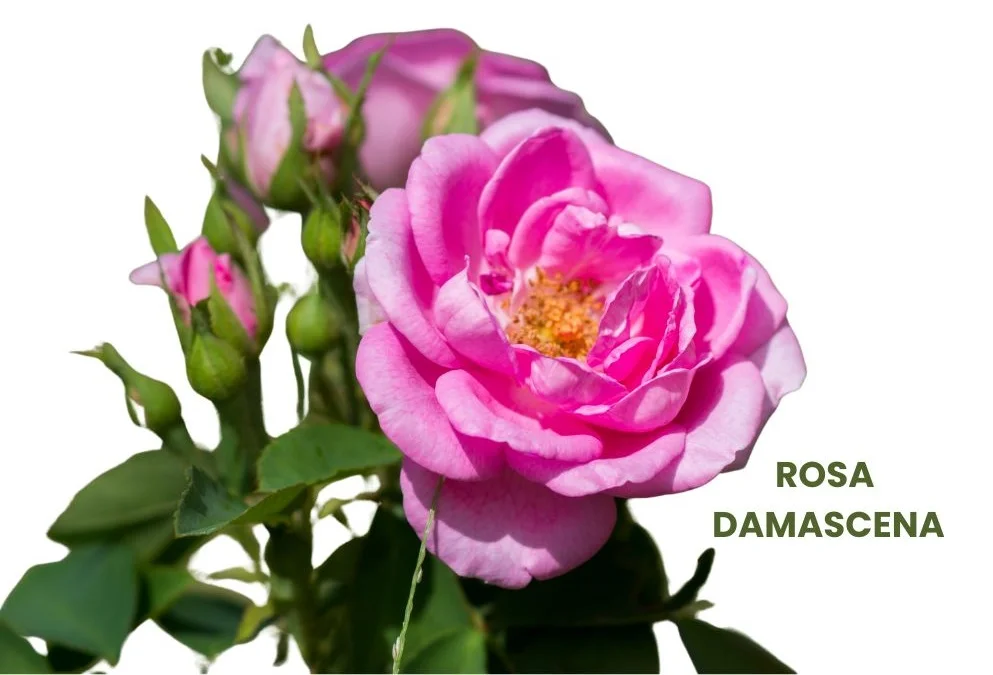Rosa Damascena, commonly known as the Damask Rose, is a homeopathic remedy renowned for its effectiveness in treating the early stages of hay fever, particularly when accompanied by Eustachian tube involvement.
The Damask Rose is celebrated for its soothing properties and is used to address symptoms associated with allergic reactions and respiratory tract conditions.

Table of Contents
ToggleSOURCE INFORMATION
Scientific Classification
- Kingdom: Plantae
- Clade: Angiosperms
- Clade: Eudicots
- Order: Rosales
- Family: Rosaceae
- Genus: Rosa
- Species: R. damascena
Origin
- The Damask Rose is native to the Middle East, particularly Iran, Turkey, and Syria.
- It has been cultivated for centuries for its fragrant flowers and is used in perfumes, cosmetics, and traditional medicine.
Historical Facts
- The Damask Rose has a long history in various cultures for its aromatic and medicinal properties.
- Historically, it has been used in Persian and Ottoman medicine for treating a range of ailments, including digestive disorders and respiratory issues.
- The rose has also been prized for its role in perfumery and cosmetics due to its pleasant fragrance and beneficial properties for skin care.
DRUG PATHOGENESIS
- Rosa Damascena is primarily used to alleviate symptoms of hay fever, especially during the initial stages of the condition.
- It is particularly beneficial when there is involvement of the Eustachian tube, which can cause hearing issues and tinnitus.
- The remedy addresses inflammation and irritation in the respiratory tract and Eustachian tube.
KEY CHARACTERISTICS
- Hay Fever: Effective in the early stages, particularly with Eustachian tube involvement.
- Eustachian Tube Symptoms: Helps with symptoms such as hearing difficulties and tinnitus.
- Respiratory Relief: Provides relief from symptoms associated with allergic reactions affecting the respiratory tract.
DETAILED ORGAN SYMPTOMS
EAR
- Hardness of Hearing: Difficulty in hearing due to congestion or inflammation affecting the Eustachian tube.
- Tinnitus: Ringing or buzzing in the ears, often associated with hay fever.
- Eustachian Catarrh: Inflammation and congestion of the Eustachian tube, causing discomfort and affecting hearing.
MODALITIES
- Worse: Exposure to allergens or irritants that exacerbate hay fever symptoms.
- Better: Avoidance of triggers and rest.
WHAT ARE MODALITIES IN HOMOEOPATHY?
RELATIONSHIP WITH OTHER DRUGS
Compare with,
- Phleum pratense (Timothy Grass): For hay fever with asthma, watery coryza, itching of the nose and eyes, frequent sneezing, and dyspnea. Use in potencies ranging from 6 to 30.
- Succinic Acid, Sabad, Euphrasia, Psorinum, Kali hydriodicum, Naphthalin: These remedies are used in conjunction or comparison for treating symptoms of hay fever and related allergic conditions.
Complementary: May be used alongside remedies for chronic hay fever or respiratory conditions as advised by a practitioner.
DOSE
- Potency: Lower potencies are recommended for acute symptoms. Dosage should be adjusted based on individual needs and severity of symptoms.
Frequently Asked Questions
What symptoms can Rosa Damascena treat?
- It is effective in treating the initial stages of hay fever, especially with involvement of the Eustachian tube, leading to hearing issues and tinnitus.
How should Rosa Damascena be administered?
- It is typically used in lower potencies.
- Dosage should be tailored to individual symptoms and severity, following guidance from a homeopathic practitioner.
Can Rosa Damascena be used for children?
- Yes, it can be used for children experiencing early-stage hay fever symptoms, but dosage should be adjusted appropriately.
What should be avoided while taking Rosa Damascena?
- Avoid known allergens or irritants that trigger hay fever symptoms.
- Maintaining a clean environment can help reduce symptoms.
Glossary of Difficult Words
- Eustachian Tube: A tube that connects the middle ear to the back of the nose and helps equalize pressure.
- Tinnitus: A condition characterized by ringing or buzzing sounds in the ears.
- Catarrh: Inflammation of a mucous membrane, especially in the nose or throat.
This detailed drug picture of Rosa Damascena provides a comprehensive overview of its uses, symptoms, and administration, aiding both practitioners and patients in managing hay fever and related conditions effectively.
